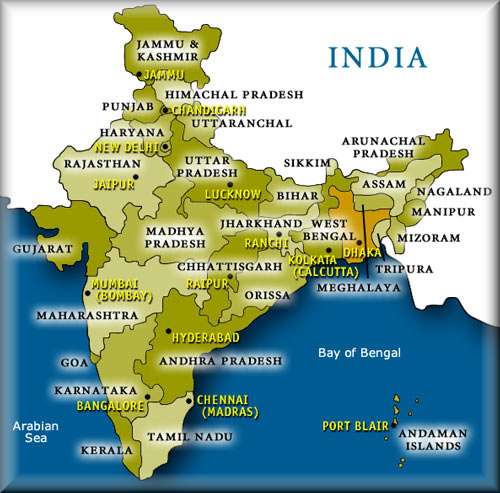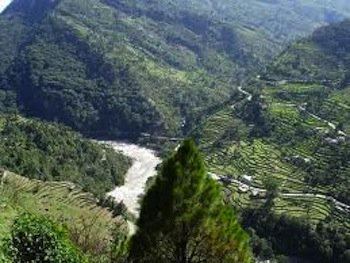The Indian State of Uttarakhand
Uttarakhand is Known as God's Land
The Indian State of Uttarakhand is located in the northeastern region of India. Its name means "North County" or "North Section" in the ancient Indian language of Sanskrit. It is one of many Indian States. It shares borders with Tibet and Nepal to its east, Chandigarh to its west, Himachal Pradesh to its north, Haryana and New Dehli to its southwest, and Uttar Pradesh to its southern side.
A census completed in 2011 found Uttarakhand had a population of 10,116,752. Believe it or not, for India, this is quite small. India has the larges population of any country in the world! The native tribes here are known as the Kumaoni and Garhwali. They come from the state’s Garhwal and Kumaon regions. Many refer to this state as “God’s Land” because it houses Hinduism's four most sacred temples, known as the Char-dhams.

The Char-dhams are located in the mountains here. The Char-Dhams is their collected name, but the four temples are named the Badrinath, Kedarnath, Gangotri and Yamunotri temples. The State’s Capital is Dehradun. Dehradun is known as one of the most beautiful places to visit in India. It lies on the watershed of the Ganga and Yumana Rivers and boasts plush greenery all around.
The Geography of the Indian State of Uttarakhand
The Geography of this diverse state boasts fresh water streams and rivers flowing through vast forests and snow capped mountains. Many of these streams and rivers are in result to melting glaciers from snow-capped mountain peaks. Its unique bio-diversity allows for 175 rare species of aromatic & medicinal plants to flourish here.
Uttarakhand is rich in valuable natural mineral deposits like limestone, marble, rock phosphate, dolomite, magnesite, copper, gypsum and more. Jobs related to these resources generate employment for thousands of the residents that live in the area. Many people also find work in the handicraft industry, making goods and services that are sold to locals and to tourists alike.
The History of the Indian State of Uttarakhand
The region was first inhabited by an ancient tribe called the Kols. They were aboriginal people of Austro-Asiatic origin, who were later joined by Indo-Aryans from northwest during the Vedic Age. Religious Hindu legend has it that a sage by the name of Vyasa wrote the Mahabharata, one of India’s two Sanskrit Epics and that it was written in this state.
In the second century BC, the Garhwal and Kumaon practiced an early form of Shaivism, a branch of Hinduism. The early people of this region traded goods with Tibet. In fact, Buddhism was first introduced here, in India, before it made its way to Tibet. Various tribes took control of the region during the ancient history of India.
During India's medieval period, the western part of the state was controlled by the Garhwal Kingdom and the eastern part was controlled by the Kumaon Kingdom. From the 13th–18th century, Kumaon prospered under the Chand Rajas (Kings). Education and new forms of painting developed during their rule. This continued until a new power called the Gurkhas took over.
The east was unified under a ruler named Parmar, until it too fell under the control the Gurkhas. However, the Anglo-Nepalese War, which concluded in 1816, led to the Garhwal Kingdom being reestablished and to Eastern British Garhwal and Kumaon becoming a part of the British Territories of India in the Treaty of Sugauli. India was under British Rule for quite some time.
After India gained its independence from Britain, the Garhwal Kingdom became part of the modern Uttar Pradesh state. On September 24, 1998, Uttar Pradesh’s Legislative Assembly passed the Uttar Pradesh Reorganization Bill, which led Parliament later passing the Uttar Pradesh Reorganization Act of 2000. The Reorganization of 2000 made Uttarakhand the 27th state of India on November 9, 2000. At that time, the state was named Uttaranchal, but in August 2006, the state was renamed.
Uttarakhand has emerged as a major manufacturing hub, a tourism hub, and has made infrastructure investments. The state is currently making efforts to grow its economy by improving its agriculture and public services sector. The local Government has written policy to encourage further outside investments into a number of sectors of the local economy.
The state’s top tourism destinations are the Corbett National Park and Tiger Reserve, and the Char-Dam Hindu Temples. In addition, there are many nearby hill stations to visit in Nainital, Mussoorie, Almora, Kausani, Bhimtal and Ranikhet. This state is a must see for Hindus and is convenient to visit due to its regional proximity to the Taj Mahal in Uttar Pradesh. There is a lot to see when visiting India, but this is a good location to include in your itinerary.
Leave Uttarakhand to visit the other Indian states.
Visit our homepage to continue exploring India.



